Content
Marigolds are probably known to everyone, they are one of the most unpretentious flowers. Bright, sunny flowers will decorate any flower bed or balcony. Marigolds are real workers; their flowering lasts all summer until the very frost.
These plants can be used not only as a decoration for the garden, but also as a medicinal plant, seasoning in cooking and as a means for cosmetic procedures. From this article you will find out what marigolds are, varieties with photos and names are described below.
See also: "When to plant marigolds for seedlings"
Types of marigolds
Thin-leaved
This species includes mostly low plants. They have compact bushes, the growth of which does not exceed 50 centimeters. The foliage is small, dissected flowers are simple. Thin-leaved varieties look good in flower beds and in combination with other types of marigolds, they can also be grown in balcony conditions. Now let's consider the most popular varieties of this type.
Lemon Jam
The plant grows to a height of only 35 centimeters, the flowers are small lemon-colored, the bushes are minimal in shape, branches with abundant flowering.
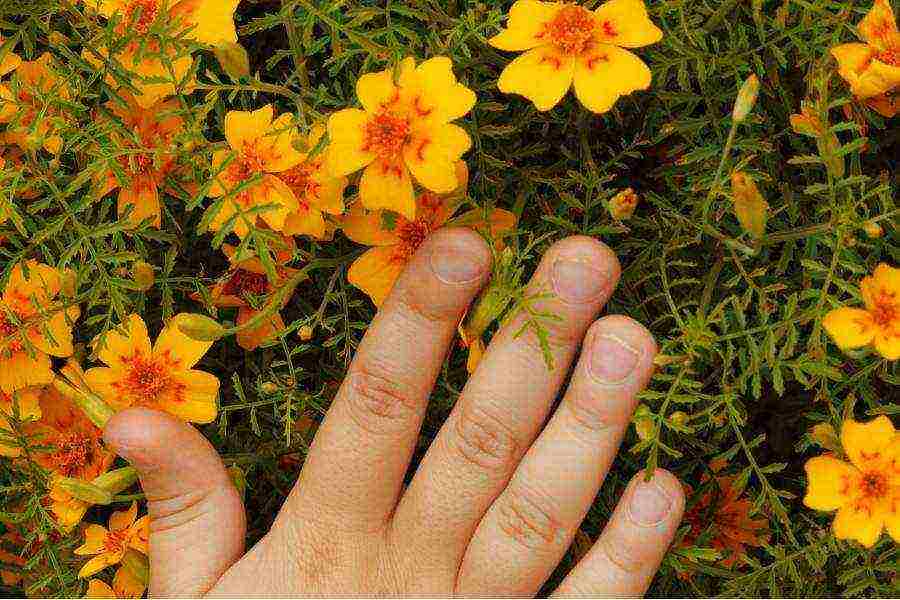 Lemon Jam
Lemon Jam
"Dwarf"
It grows up to 25 cm, the plant has the shape of a ball, the foliage is thick, delicate. This variety blooms before the rest. The flowers have a yellow center and brown petals around the edges.
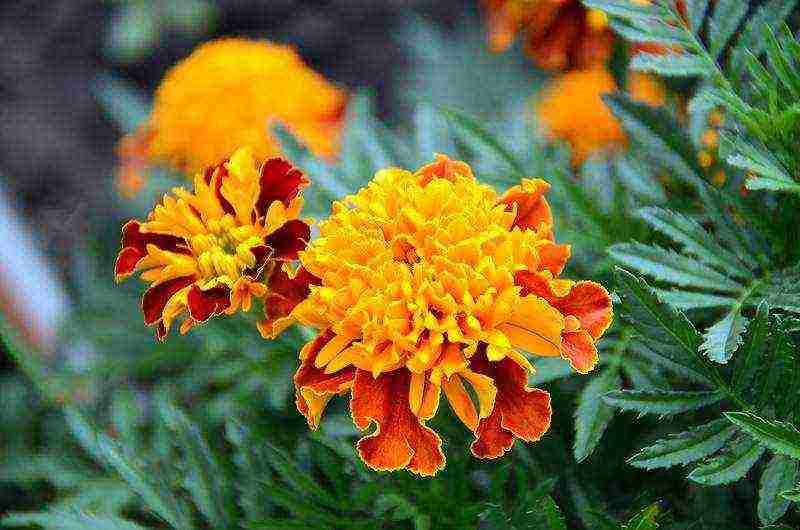 Dwarf
Dwarf
Golden Ring
The plant forms shoots up to 50 cm, flowers are yellow, small flowers begin to bloom in June and end with the onset of the first frost.
 Golden Ring
Golden Ring
"Mimimix"
The plant forms small dense bushes up to 25 cm, flowers are small, simple.
 Mimimix
Mimimix
Marigolds erect
The tallest varieties belong to this species, they reach 100 cm. The flowers grow large, up to 15 cm, of the same color, double type. In addition, marigolds are divided into the following sizes: super high -90 cm, tall - 60-90 cm, low less than 45 cm
Erect marigold varieties with photos and descriptions:
 A remedy from which plants grow by leaps and bounds! Just water your plants with it ...
A remedy from which plants grow by leaps and bounds! Just water your plants with it ...
"Hawaii"
These plants reach 105 cm, flowers are large, with a shade of orange, 12 cm in size, bloom late in the late summer.
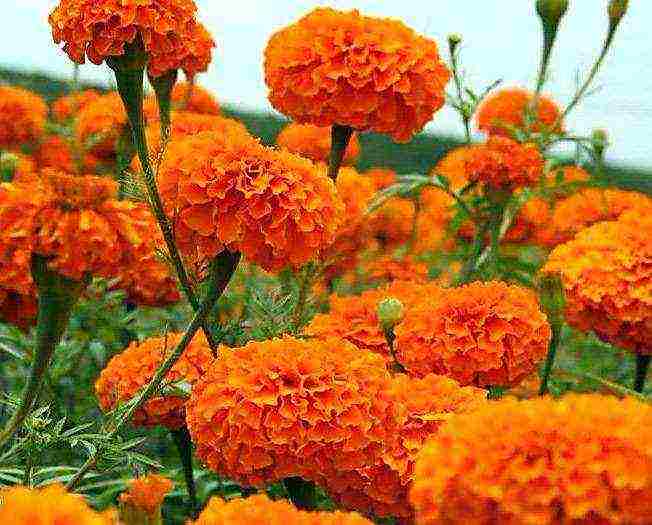 Hawaii
Hawaii
"Gold Dollar"
The bushes look miniature, they grow 120 cm in height, the trunks are powerful, the foliage is light green, the flowers are rich orange.
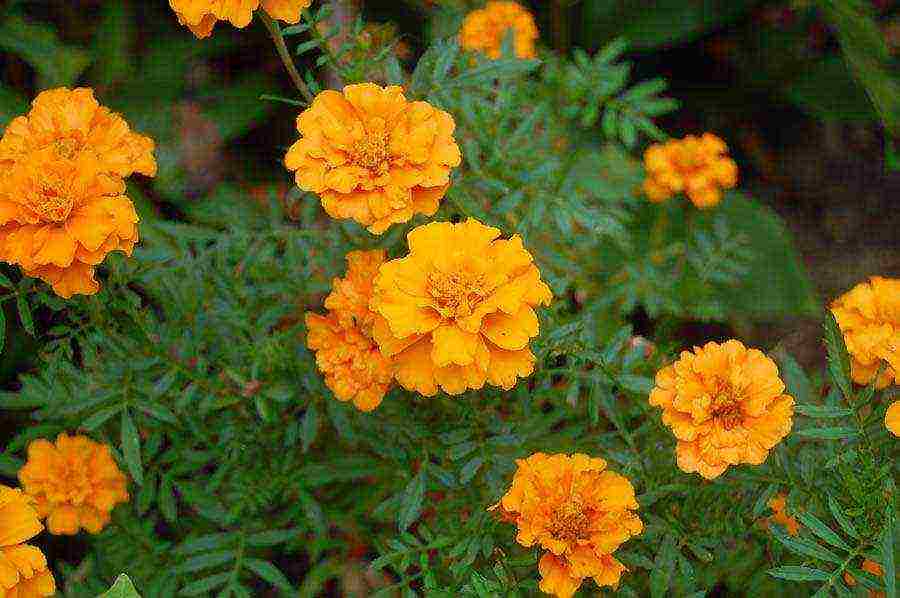 Gold Dollar
Gold Dollar
"Eskimo"
The plant grows to a height of 35 cm, the flowers are milky, the size of the peduncle is up to 6 cm.
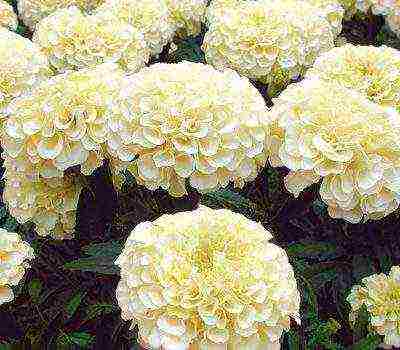 Popsicle
Popsicle
Freels
Plants form small bushes up to 80 cm, flowers are large, with a yellow center and orange edges, blooms in late July.
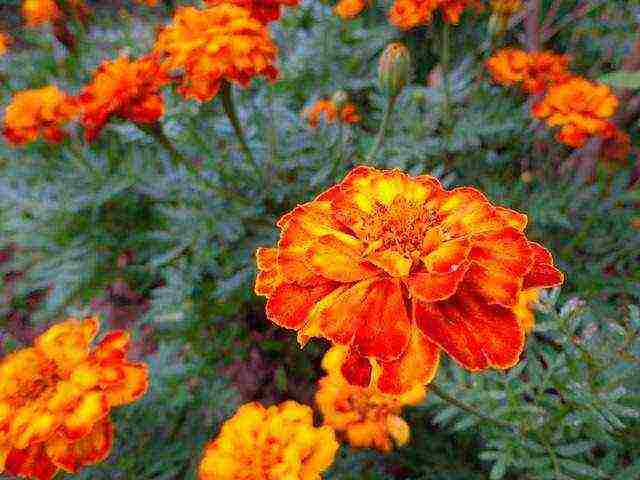 Friels
Friels
"Mandarin"
It blooms with lush orange flowers, the bush itself is dense, densely branched.
Mandarin
Marigolds rejected
In another way, this species is called French, it is characterized by a large range of color shades. The bushes reach a length of no more than 60 cm.The flowers are double and simple, they are small only 8 cm.For convenience, the variety is distributed according to the classification: tall - 60 cm, medium up to 50 cm, low 20-40 cm, the lowest 15-20 cm ...
Here are the most popular varieties of rejected velvets:
"Bolero"
A relatively new variety that has managed to fall in love with flower growers. The flowers are not large, lush, a shade of red with brown and a small splash of lemon color. The bushes are not high, about 30 cm. These marigolds grow rapidly, bloom a lot throughout the summer season.
 Bolero
Bolero
"Fighter"
Lush bushes, grow up to 50 cm.The foliage is deep green, openwork. Flowering begins in early summer.
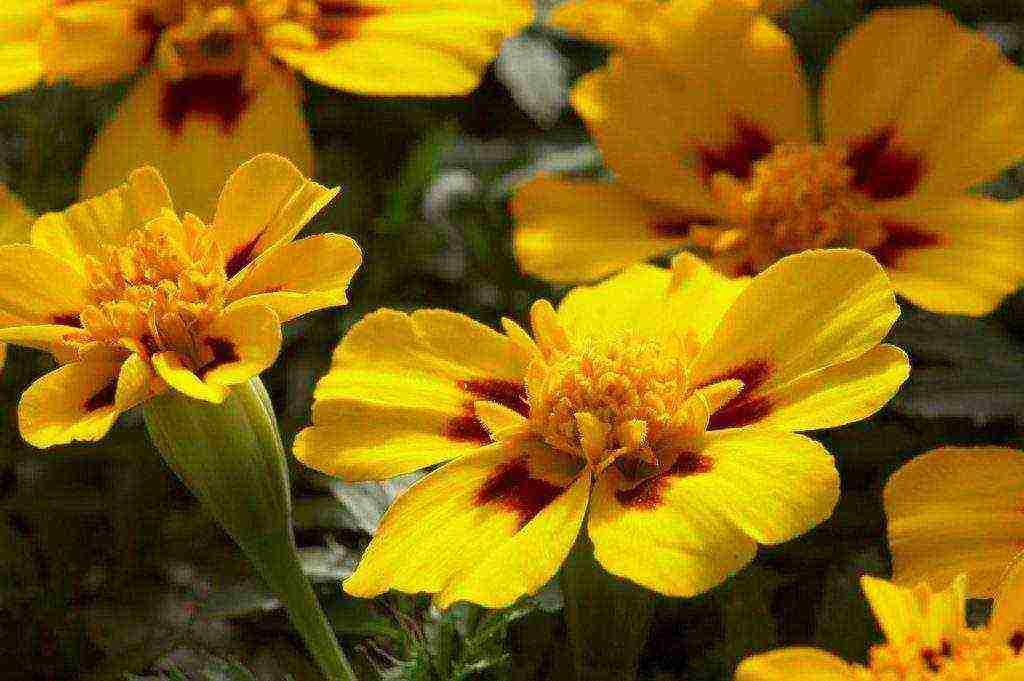 Fighter
Fighter
Jolly Jester
These marigolds branch well, the bush itself grows up to 30 cm, the flowers have several shades.
 Jolly Jester
Jolly Jester
"Gold Ball"
Sprawling bushes, up to 60 cm in height, green shoots with brown bloom, flowers are simple or semi-double, about 5 cm in diameter. The variety blooms in early June, flowers can be used for cutting.
 Gold Ball
Gold Ball
The smallest varieties
A variety of low-growing marigolds are widely used to create flower beds and flower beds. Shades of colors are yellow, orange, reddish, and brown. Basically, dwarf varieties of marigolds curl strongly, they reach a height of 20-35 cm. The smell of flowers is well pronounced, but somewhat softer than that of other species.
Here are the undersized varieties with good photos, which are the most beloved marigolds among flower growers:
"Carmen"
Refers to rejected marigolds, the bush reaches up to 30 cm, the flowers are brown-red with a yellow center in a diameter of 6 cm.
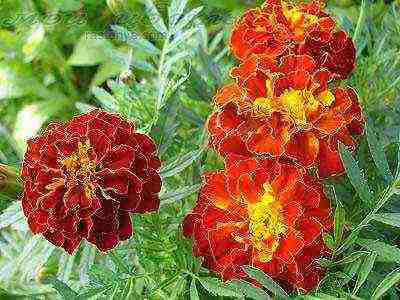 Carmen
Carmen
"Petite orange"
The bushes of this plant are very miniature, only 25 cm, the foliage is bright green, dense, orange flowers are not large 6 cm in diameter, double.
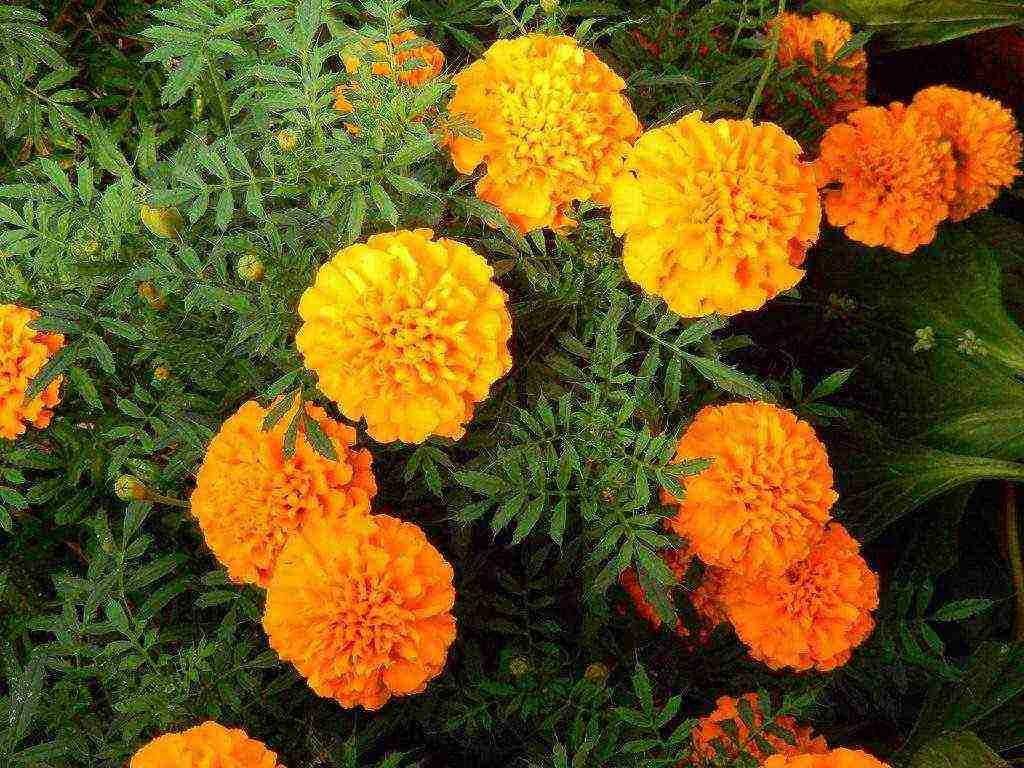 Petite orange
Petite orange
"Golden Head"
This plant has a height of only 20 cm, dense bushes with strong shoots, foliage of a dark green hue. Double flowers resembling chrysanthemum about 4 cm in diameter. These marigolds bloom early in early June, profuse flowering lasts until the first frost. The variety is suitable for growing in pots, balconies, flower beds and beds.
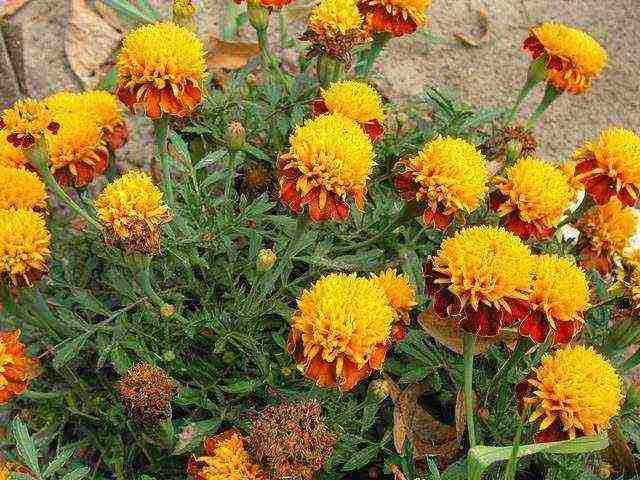 Gold head
Gold head
"Bonanza"
The cultivar consists of a series of plants with a variety of colors. The flowers are yellow, white, reddish brown and orange. All terry inflorescences are 6 cm in size.The size of the bush is from 25 to 30 cm.
 Bonanza
Bonanza
Low-growing large-flowered varieties are determined by powerful stems, dark green foliage, large double inflorescences. The color of flowers can be lemon, yellow, orange.
Antigua
The variety is erect, the height of the bush does not exceed 25 cm. The inflorescences are large enough in size 15 cm, terry. 4-5 flowers bloom on one bush, they have a monochromatic color. Flowering begins early in late May and lasts two months.
 Antigua
Antigua
Lunasi
A beautiful undersized variety with large chrysanthemum-shaped flowers, predominantly orange. Flowering begins two to three months after germination.
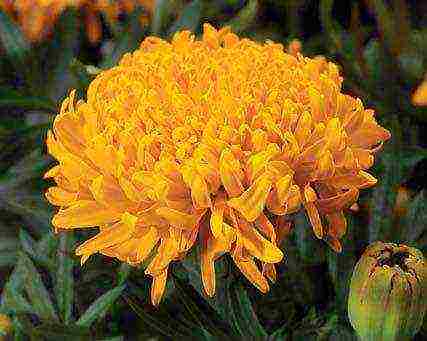 Lunasi
Lunasi
Perennials among the velvet
Perennial marigolds grow in natural conditions in hot countries. In the climatic conditions of our country, velvet flowers can grow like annual flowers, because they die due to frost. But due to the abundant ejection of seeds and their germination in the same place in the next season, the effect of perennials is achieved. Perennial varieties marigolds grow in Mexico, America, but here are the plants most resistant to climatic anomalies: Bicolor French, Bonita, Golden Domes, Khokhloma, Mexican Tarragon, Sofia.

Planting seeds in the ground
Marigolds are easy to grow from seeds. Planting in flower beds begins at the end of May, when the soil warms up well. It is better to choose an open sunny place, far from water bodies, light partial shade is allowed. For convenience, furrows can be made with a hoe, then spilled with water.
The seeds are laid out about 1.5-2 cm from each other, and sprinkled with soil 0.5-1 cm.Further, the plantings are watered and covered with a covering material so that the moisture does not evaporate so much, of course, if rains are predicted, then this is possible and not to do.
After about five days, velvet shoots will appear, the covering tissue is removed, if there is a severe drought, the plants need watering. When the second pair of real leaves appears, the places where the marigolds have sprouted densely are thinned out. Excess plants can be planted in beds with cabbage, tomatoes, peppers, carrots.The fact is that all parts of marigolds secrete phytoncides that scare off pests and fight pathogenic microflora, including such a common fungus as late blight.
When planting these plants, depending on the variety, certain conditions are observed. So between tall marigolds, you need to adhere to a distance of about 40 cm, between medium-sized plants they stand 30 cm, and low velvet marigolds are seated at a distance of 15-20 cm.
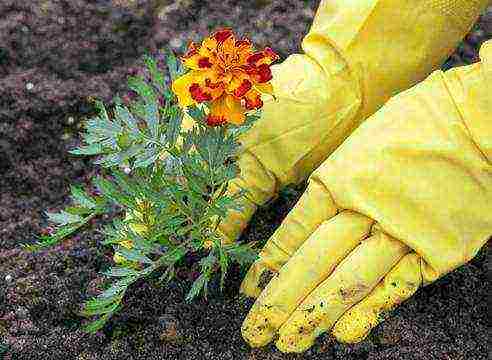
We grow marigold seedlings
If you want to get flowering plants early, then you need to sow seeds for seedlings. They do this in late March or early April, when daylight hours increase so that the marigolds have enough sun for full growth.
The primer can be selected ready-to-use or universal. If you prefer to use land from your site or forest land, then you must decontaminate it. To do this, use a pink solution of potassium permanganate, or spill it with boiling water several times. Containers can be immediately taken deeper; on the bottom it is necessary to put a drainage layer of expanded clay or other material.
In wet soil, grooves are made one centimeter deep, spread the seeds and covered with soil. Next, the crops are moistened from the pulverizer so as not to erode the soil. For germination of marigold seeds, a temperature of 20 degrees is suitable. Boxes with seedlings are covered with a film with small cuts so that moisture evaporates less.
Within about five, seven days, depending on the variety, the marigolds will sprout. Now the container can be transferred to well-lit places, with a temperature of 15-18 degrees. Most likely, in the apartment this will be a place on the windowsill. After the plants have 2-3 pairs of real leaves, the plantings can be thinned out by replanting excess plants into another container.
Seedlings are transplanted to a permanent place in mid or late May. But flower growers should pay attention to the weather forecast, and if there is a threat of frost, the plants are covered with high-density material or plastic wrap.
Care
Marigolds have bright and beautiful flowers, delicate foliage, but many growers decide to plant these plants due to the fact that they do not need special care. Flowers easily tolerate dry days, temperature changes, grow well, bloom profusely and do not get sick. Plants also do not need feeding. Caring for velvet flowers consists in weeding, watering and removing faded buds in order to provoke a longer flowering.
Growing and caring for these flowers is not difficult at all. And there are a lot of varieties of marigolds, so everyone will find a suitable option.
See also: "Subulate phlox: planting and care"
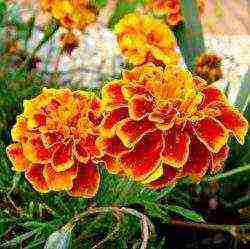 Despite the fact that the homeland of marigolds is South America, they have successfully taken root in our area. And so much so that they began to grow everywhere: both in city parks and gardens, and in private garden plots. These bright flowers, unpretentious to care for, delight the eye until late autumn. Today you will get acquainted with the best varieties of marigolds. A detailed description of the varieties is presented to your attention, as well as a photo selection with the names of individual varieties.
Despite the fact that the homeland of marigolds is South America, they have successfully taken root in our area. And so much so that they began to grow everywhere: both in city parks and gardens, and in private garden plots. These bright flowers, unpretentious to care for, delight the eye until late autumn. Today you will get acquainted with the best varieties of marigolds. A detailed description of the varieties is presented to your attention, as well as a photo selection with the names of individual varieties.
Description of the plant
Annual / perennial plant belonging to the Astrov family. Differs in a variety of stem length (from 15 to 130 cm) and the presence of a fibrous root system. The flowers grow large enough to form a lush bush that can be a worthy decoration for any flower bed or garden.
The leaves of the plant are pinnate, solid, jagged. The color of the leaves is pale green and even a rich green hue. Inflorescences on the bush are found both single and Compositae. A distinctive feature of marigolds is their bright saturated color (yellow, orange, brown and multicolored with a red variegated dusting) and a kind of delicate aroma.
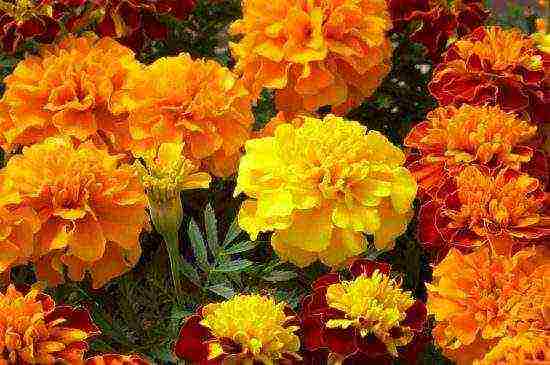
Blooming marigolds
Marigolds are distinguished by generous beautiful flowering, which begins with the arrival of a warm summer and ends in late autumn (sometimes up to the first frost).
Advice. If you want to add zest to your garden, but do not know which plant to choose from, you should pay attention to marigolds. Having correctly selected the right variety, you will not only not spoil the appearance of the garden with its help, but also enhance the pleasant impression. In addition, marigolds are mostly a perennial plant, so for 3-4 years you can enjoy their beauty carefree.
Classification of marigolds
Despite the fact that there are annual and perennial varieties of marigolds, the latter are most often used in gardening. Marigolds are also classified by the height of the bush: giant (about 1.5 m and above), tall (about 0.6 m), medium (no higher than 0.5 m), undersized (up to 0.4 m), dwarf (maximum height - about 0.15-0.2 m).
Main types
Despite the variety of varieties of marigolds, only a few main types of this plant can be distinguished:
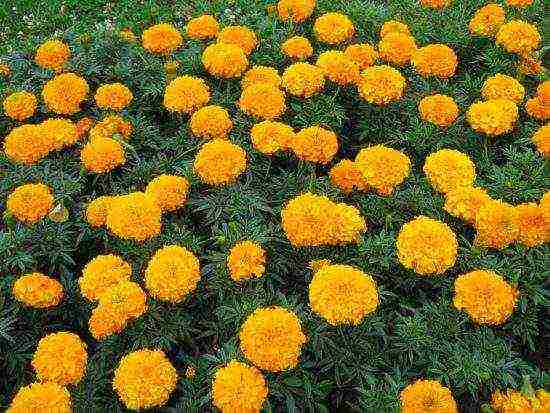
Erect marigolds
- Erect (African). This species is characterized by sprawling erect bushes, covered with a thick "carpet" of double rounded inflorescences. The diameter of the flowers is, on average, about 10-12 cm. The stems of the plant are large enough, strong, reaching 1 m in height. This variety is most often used in group compositions, in flower beds and even in small bouquets.
Advice. If you have chosen a variety belonging to this species, keep in mind: poor moisture tolerance is considered a significant drawback of the African variety of marigolds. With frequent and heavy rains, the flowering begins to lose its original appearance, and the plant itself decays over time.
- Small flowers (French). A low variety of a plant - does not exceed half a meter in height. The inflorescences are also quite small - only about 3-5 cm in diameter. The plant pleases with its flowering until mid-autumn. The flowers are characterized by a monochromatic orange color (sometimes they are two-colored). Most often used to create beautiful edging around curbs. They are unpretentious in leaving.
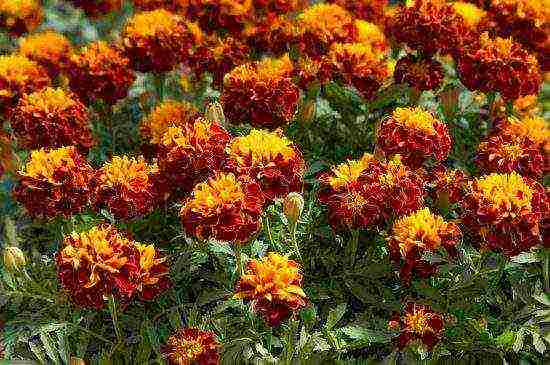
Small-flowered marigolds
- Thin-leaved. Thin-leaved marigolds grow as a very compact bush, not exceeding 0.4 m in height. Inflorescences are slightly reminiscent of chamomile in shape, but have a rich yellow color. The size of the flowers is small - only 3 cm in diameter. Most often used to create bright compositions in small flower beds. Also used in cooking (as a seasoning). Demanding in care: they love light and warmth.

Thin-leaved marigolds
- Small (graceful). Despite its name, marigolds of this species are truly gigantic in size - the height of the bush sometimes exceeds 1.2 m. But the inflorescences themselves look very graceful, neat, and differ in tiny sizes. They are often used in cooking.
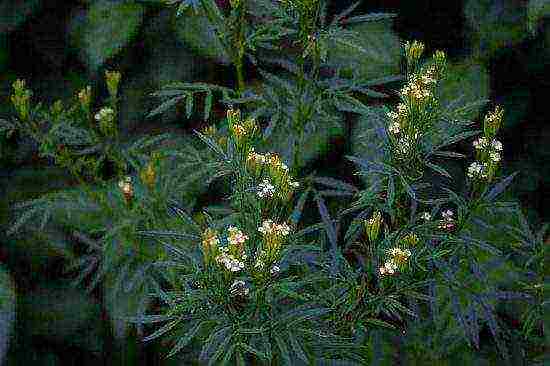
Small marigolds
Hybrid views
Separately, there are several varieties of marigold hybrids:
- Antigua. This dwarf hybrid (about 30 cm) is most often used for compacting and decorating garden plantings. Differs in a variety of color shades of its inflorescences: yellow, lemon, golden, etc.
- Aztec Lime Green. Bushes of medium height (about 0.4 m) at their tops proudly bear lush terry inflorescences of a delicate lime color with a green tint.

Aztec Lime Green
- Lunasi. These undersized African marigolds are incredibly small (about 15 cm) and unusual-looking inflorescences - they look like chrysanthemums. They bloom unusually quickly (in just a couple of months) and fade just as quickly.
- Vanilla. An unusual hybrid, which got its name from the inflorescences of a delicate vanilla color. Used exclusively for propagation in flower beds and pots (after cutting).
- Amber. The hybrid is represented by low bushes with powerful stems bearing bright orange double inflorescences.The species pleases with its early flowering and resistance to adverse climatic factors.
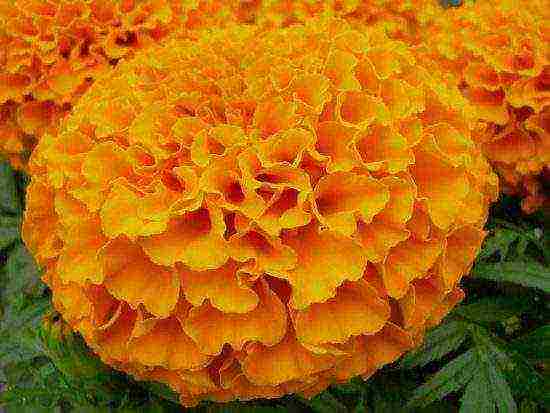
Amber
- Cloves. Grown exclusively for further cutting. They differ in medium size and powerful beautiful inflorescences.
The hybrid varieties presented above are just a few of the wide variety of marigold plants.
Popular varieties
Consider some of the most popular marigold varieties, most often used for growing in small flower beds, private gardens and for decorating city flower beds. Among the large number of African varieties, the following can be distinguished:
- Gold Dollar. The variety is compact and at the same time large in size (small in width, but high - more than 1 m). The flowers are orange with red accents.
- Kilimanjaro. A hybrid variety intended exclusively for cutting. The size of the bush is large - it reaches a height of 0.6-0.7 m. Lush marigolds have an unusual white color for a plant.

Kilimanjaro
- Glitters. An unusual variety, represented by giant bushes - about 1.1 m. At the same time, the inflorescences grow in rather rare groups, they are small in size - about 5 cm in diameter.
- Smile. This late-flowering variety is represented by a rather powerful developed bush about 1 m high. The inflorescences are large, yellow in color (sometimes several shades of yellow overlap on one inflorescence: light yellow, lemon, golden, etc.).
Among the French varieties, the following can be distinguished:
- Naughty Marietta. One of the most popular varieties. Unpretentious in care, blooms for a long time. The bushes have an average height - no more than 0.4 m. The flowers grow densely, outwardly resemble chamomile. The color of marigolds is bright yellow, with a reddish core.
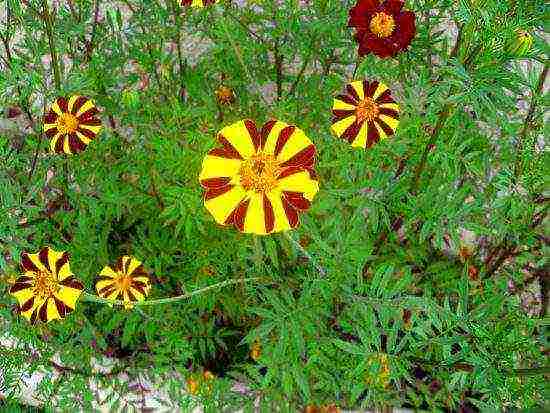
Naughty Marietta
- Fighter. A variety with an unusual appearance: marigolds outwardly resemble chamomile flowers. They grow very densely, creating a beautiful lush bush. They do not bloom for long - only at the beginning of summer.
- Bolero. A relative newcomer to the wide variety of marigold varieties. Already managed to catch the fancy of Russian gardeners. Bushes grow quite small - only about 0.3 m. Flowers on them are also small, double. The color is unusual - rich red with small yellow blotches. It blooms for a long time, unpretentious in care.
Among the Mexican varieties, the following can be distinguished:
- Mimimics. An unusual variety, represented by compact bushes with dense dense flowering of small marigolds. During the period of active flowering, the bushes form a natural low-growing flower bed. They can be a worthy decoration even for a large garden.

Mimimix
- Lemon Jam. Also a low-growing variety (bushes grow to a height of no more than 0.3 m). Marigolds grow densely, but have a very small size (outwardly they resemble chamomiles). The color of the flowers is lemon.
- Dwarf. An excellent variety for the formation of small flower beds. Dwarf bushes. The inflorescences are single, medium-sized, have a red-brown color along the edges and a yellow core.
So our acquaintance with marigolds has come to an end. Now you know how diverse this plant is, and you can choose the best variety for your garden from a considerable number of options presented. Good luck!
Growing marigolds: video
- Marigolds - description, structure, characteristics. What do marigolds look like?
- Types and varieties of marigolds, photos and names.
- Erect marigolds (African) (lat.Tagetes erecta).
- Rejected marigolds (lat.Tagetes patula).
- Narrow-leaved marigolds (thin-leaved, Mexican) (lat.Tagetes tenuifolia).
- Radiant marigolds (bright, clear) (lat.Tagetes lucida).
- Nelson's marigolds (lat.Tagetes nelsonii).
- Lemmon marigolds (lat.Tagetes lemmonii).
- Marigolds Tagetes filifolia.
- Small marigolds (lat.Tagetes minuta).
- Classification of marigolds by the height of the bush.
- Giant marigolds, varieties, photos and names.
- Tall (tall) marigolds, varieties, photos and names.
- Medium-sized marigolds, varieties, photos and names.
- Marigolds are undersized, varieties, photos and names.
- Dwarf marigolds, varieties, photos and names.
- Types of marigolds in the shape of inflorescences, photos and names.
- Simple marigolds, varieties, photos and names.
- Semi-double marigolds, varieties, photos and names.
- Terry marigolds, varieties, photos and names.
- Anemone marigolds, varieties, photos and names.
- Clove (clove) marigolds, varieties, photos and names.
- Chrysanthemum marigolds, varieties, photos and names.
- Where do marigolds grow?
- The healing properties of marigolds.
- How to make marigold oil?
- Marigold infusion and method of its preparation.
- Marigold broth and cooking method.
- The use of marigolds in cosmetology.
- Marigolds in cooking.
- Harm of marigolds and contraindications.
- Marigolds: growing and care.
- The soil.
- Temperature and lighting.
- Humidity.
- Ways of planting marigolds.
- When to plant marigolds?
- Germination of marigold seeds.
- Planting marigolds by seeds in open ground.
- Planting marigolds for seedlings.
- Planting marigold seedlings in open ground.
- Marigold care.
- Diseases of marigolds, photos and names.
- Interesting Marigold Facts:
Marigolds (lat.Tagetes) - flowers that differ in many species and varieties, among them there are both annual and perennial varieties. Marigolds, or marigolds, belong to the dicotyledonous class, the superorder Asteranae, the astrocyte order, the aster family, the aster subfamily, the marigold tribe, the marigold genus.
International scientific name: Tagetes (Linnaeus).
Although this amazing flower was introduced to Europe in the 16th century, it received its scientific name only in the middle of the 17th century, when the naturalist Carl Linnaeus was creating a classification of species. The scientist, amazed by the beauty of the plant, named it after the beautiful Etruscan demigod Tages, who is the grandson of the supreme god Jupiter.
The flowers received the Russian name "marigolds" because of their petals, the surface of which resembles velvet. This feature is most pronounced in varieties with a dark color.
The British call this plant "marigold", which means "Mary's gold", the people of Germany know it as "Studentenblume" - a student's flower, and in Ukraine these beautiful flowers are called "black-shaved", or black-shaved flowers. For the inhabitants of China, these flowers are a symbol of health and longevity, it is not for nothing that they are called "flowers of a thousand years."
back to contents ↑ Marigolds - description, structure, characteristics. What do marigolds look like?
Marigolds have a developed fibrous root system and strong strong erect stems... Depending on the species or varietal accessory, the bushes can be of both compact and spreading type with a height of 20 cm to 2 meters.
Leaves marigolds, painted in all tones of green, are pinnately dissected, pinnately separate, or even whole with edges cut into teeth. On the stem, the leaves can be arranged in the next order or opposite each other (opposite).
Inflorescences marigolds are formed from tubular and ligulate flowers, in which wide corollas are located horizontally. Depending on the shape and number of petals, marigolds are:
- Simple (non-double) - inflorescences, which have from 1 to 3 rows of reed petals;
- Semi-double - inflorescences with no more than 50% reed petals;
- Terry - flowers with more than 50% reed or tubular petals. Terry marigolds, in turn, are subdivided according to the shape of the inflorescences into:
- Anemone (reed petals are located along the edges of the inflorescence, and tubular in the center);
- Carnation, or clove-shaped (only reed petals are present in the inflorescence);
- Chrysanthemum (only tubular petals are present in the inflorescence).
Petal color marigolds can be:
- yellow,
- reddish brown
- Orange,
- White,
- citric,
- motley.
The inflorescences themselves have a rather sharp and specific aroma, which vaguely resembles the smell of asters.The flowering period of marigolds begins in June and lasts until the onset of frost. After its completion, a strongly flattened fetus black-brown or black in color. Each such seed pod contains many seeds that remain viable for 3-4 years. 1 gram usually contains from 270 to 700 seeds.
back to content ↑ Types and varieties of marigolds, photos and names.
According to the www.theplantlist.org database, there are currently 53 species of annual or perennial marigolds, the most famous of which are only 3 species (erect, deviated and thin-leaved). On their basis, breeders have developed a huge number of series and varieties. Below is a description of several varieties of marigolds.
Erect marigolds (African) (lat.Tagetes erecta).
This species includes annual plants with a fibrous root system. The compact or spreading bushes formed by these marigolds have a height of 0.4 to 1.2 meters and are inversely pyramidal in shape. The main shoot is pronounced, the lateral shoots look up. The color of unpaired pinnately dissected leaves with denticles along the edges varies from light green to dark green, and they are located on the stem in the next order. Large monochromatic, less often bicolor inflorescences in marigolds of this species can be simple, semi-double or double. The diameter of the inflorescences varies from 5 to 13 centimeters. The flowering period begins in late June or early July and ends with the first frost. Erect marigolds are suitable for flower beds, ridges, vases, balconies, cutting. The homeland of upright marigolds is Southern Mexico.
Series and varieties of erect marigolds: Albatross, Alaska, Antigua, Velvet season, White moon, Snow White, Shine, Vanilla, Hawaii, Gelber Stein, Glitters, Golden Fluffy, Hussars, Discovery, Dune, Uncle Stepa, Yellow stone, Golden dollar, Golden light, Golden Prince, Golden Age, Golden Domes, Inca, Kilimanjaro, Astronaut, Crash, Crackerjack, Cupid, Lady, Lemon Queen, Lemon Pie, Lemon Prize, Lemon Miracle, Maximix, Marvel, Mary Helen, Beach Season, Prima Gold, Spoon, Solar Giants, Taishan, Titan, Trulli, Smile, Science Fiction, Clapperboard, Popsicle, Amber Lace.
Antigua variety.
back to contents ↑ Rejected marigolds (lat.Tagetes patula).
Synonyms - French marigolds or small-colored marigolds. This species is formed by perennial plants with numerous erect and highly branched stems, the height of which ranges from 15 to 60 centimeters. Lateral shoots are deflected. Cirro-dissected dark green leaves of small size with serrated edges are formed from several lobes of a linear-lanceolate shape. On the stems, the leaves are arranged both in the next and in the opposite order. Single, and also collected in corymbose inflorescences baskets of these marigolds grow up to 4-6 centimeters in diameter. The shape of the inflorescences can be simple, semi-double or double. In addition to monochromatic marigolds, many two-color varieties have been bred. The most intense flowering is observed during July and August. They begin to bloom in early June. The homeland of the rejected marigolds is the mountains of Mexico.
Series and varieties of rejected marigolds: Aluminum, Bonanza, Brocade Yellow, Gabi, Harmony, Hero, Gullebrand, Jolly Jester, Disco, Durango, Carmen, Red Cherry, Cross, Fight, Bolero, Capricious (Playful) Marietta, Little Hero, Mandarin, Mercedes, Coin, Orange Flame, Guy, Pascal, Petit Harmony, Petite Gold, Prosperity, Rusty Red, Safari, Striptease, Tiger Eyes, Fireball, Chica, Naughty Marietta.
Variety Tiger eyes.
Variety Capricious Marietta.
back to contents ↑ Narrow-leaved marigolds (thin-leaved, Mexican) (lat.Tagetes tenuifolia).
From these annuals, low, densely branched, compact marigold bushes are formed, the height of which can be from 20 to 50 cm.Straight bare shoots are light green in color. Light green small leaves of a pinnately dissected form, which are arranged in a regular order on the shoots, are formed by narrow lobes with rare teeth. Abundantly flowering corymbose inflorescences are collected from simple five-petal baskets, the diameter of which ranges from 15 to 30 mm. The color of the inflorescences is one-color or two-color. Thanks to the highly branched stems, the whole plant looks like an almost perfect ball. This species of marigold begins to bloom in early June and ends with the first frost when the temperature drops to 1-2 ° C. Narrow-leaved marigolds are used for flower beds, borders, ridges, vases and arrays. The homeland of narrow-leaved marigolds is the mountains of Mexico.
Series and varieties of thin-leaved marigolds: Gnome, Golden jam, Golden ring, Golden gem, Starlight, Starlight, Karina, Red gem, Lulu, Mimimix, Fire stars, Ornament, Paprika, Starshine, Starfire, Ursula.
Variety Ornament.
Tangerine Jam variety. Photo by: Kor! An (Korzun Andrey)
Variety Lemon Jewel
back to contents ↑ Radiant marigolds (bright, clear) (lat.Tagetes lucida).
Other names for this species: Mexican tarragon, Spanish tarragon, sweet marigold. It is a perennial upright plant with bushes 40 to 80 centimeters high. The narrow green leaves, about 7.5 centimeters long, resemble natural tarragon leaves. Monochromatic golden flowers of simple marigolds do not exceed 1.5 centimeters in diameter. Radiant marigolds bloom from early June to late September. The leaves of this plant are harvested and used fresh and dried as a tarragon substitute, and an excellent food coloring is obtained from the dried flowers.
back to contents ↑ Nelson's marigolds (lat.Tagetes nelsonii).
An ornamental, rather powerful plant, 90-120 cm high, with reddish shoots and dark green leaves. The species grows in Texas, found in Mexico. Marigolds have a very pleasant aroma of citrus fruits with a light fruity-musky note. The flowers of this marigold species are often used as a savory addition to fish and meat delicacies or as a flavorful accent in baked goods.
back to contents ↑ Lemmon's marigolds (lat.Tagetes lemmonii).
The second name is lemon marigolds. In the wild, these perennial marigolds, discovered in the late 19th century, grow in the highlands of the United States (in the canyons of southern Arizona) and in northern Mexico. The bushes of marigolds reach a height of 120 cm, the leaves of the plant are 5 to 15 cm long, the diameter of the numerous yellow flowers is approximately 5 cm.The plant exudes an aroma reminiscent of citrus and mint amber with a subtle hint of camphor. Sometimes the smell of this plant is compared to the smell of tangerines. Marigolds are attracted by many butterflies, which are constantly circling over the flowers.
back to contents ↑ Marigolds Tagetes filifolia.
A plant with a bush height of 8 to 50 cm. In the wild, this species grows in the steppes, on the slopes of rocks, in pine forests and oak forests, it feels at ease in corn fields, growing there like a weed. It is ubiquitous in a vast area from Mexico to Costa Rica. The bush has a pronounced anise aroma, the plant is quite unpretentious to the quality of the soil and easily tolerates drought.
back to contents ↑ Small marigolds (lat.Tagetes minuta).
Marigold species, with a bush height from 50 to 180-200 cm. The length of very fragrant dark green leaves varies from 5 to 20 cm, the diameter of rather small flowers does not exceed 15-25 mm. The leaves have deeply dissected edges and are located opposite to the stem. Small marigolds grow in the USA and Mexico, Brazil, southern Europe (France, Spain, Italy, Romania), southern Africa, China and Japan, India and Libya, Thailand and Turkey, Australia and New Zealand.
back to contents ↑ Classification of marigolds by the height of the bush.
In floriculture, a classification is used, in which the division is carried out according to the height of the plant, the shape of the inflorescences and their color.
The height of the bush is distinguished:
- Giant marigolds (90-120 cm);
- Tall (tall) marigolds (60-90 cm);
- Medium-sized marigolds (45-60 cm);
- Low-growing (low) marigolds (25-45 cm);
- Dwarf marigolds (up to 20 cm).
Giant marigolds, varieties, photos and names.
These include plants that reach a height of 90 cm to 120 cm. Most often, giants marigolds are found among erect plants. The most famous varieties of giant marigolds:
- Gold Dollar - an early annual hybrid variety without aroma characteristic of marigolds. The variety belongs to erect marigolds. The bushes are dense, the shoots are strong and thick, 0.9-1.2 m high, with rather large light green leaves. From the first ten days of June until the appearance of frost, they are decorated with terry baskets of medium-sized inflorescences, with a diameter of 7 to 8 cm. The inflorescences, resembling a carnation in their shape, consist of red and orange-red petals.
- Lemon Queen (Lemon Queen) - beautiful lemon marigolds with fairly high (up to 120 cm) bushes. Inflorescences are light yellow or golden in color, up to 9-10 cm in diameter. Blooms profusely in July-August.
- "Orange" - Marigold bushes of this variety reach 1 meter in height. Large (up to 15-17 cm in diameter) orange terry inflorescences delight the eye from June until the first frost, ideal for cutting - they stand in water for 2 weeks.
back to content ↑ Tall (tall) marigolds, varieties, photos and names.
The height of the bushes ranges from 60 cm to 90 cm.
- "Yellow Stone" (Gelber Stein) - a one-year-old variety, forms bushes about 70-80 cm high. The plant has beautiful densely double inflorescences of rich yellow color. The diameter of marigolds is up to 15 cm. The plant begins to bloom in early June.
- Frills - bushes of this late variety of marigolds grow up to 80 cm in height and up to 8 cm in diameter. In the last decade of July or at the very beginning of August, large, double, clove-shaped inflorescences-baskets appear on them, which consist of reed petals of saturated shades of orange and golden. Flowering from late July until the first frost.
- "Lemon Prince" (Zitronen prinz) - an upright plant forms tall (65-80 cm), standard and rather dense bushes. A pinkish bloom is visible on the dark green shoots of this variety. Terry carnation inflorescences of marigolds are rather large - 8-10 cm in diameter. When they fully open, they look like lemon yellow balls. Marigolds of this variety bloom from June-July to September.
- Hawaii - Erect annuals are compact shrubs that grow up to 90 cm in height. From mid-summer (from July) to mid-autumn, large double clove-shaped inflorescences in the form of orange hemispheres with a diameter of 10 to 12 cm open on strong light green peduncles.
back to content ↑ Medium-sized marigolds, varieties, photos and names.
The height of the plants included in this group ranges from 45 to 60 cm.
- Among white erect marigolds of medium height, perhaps one of the most beautiful is the variety "Kilimanjaro" (Kilimanjaro). This annual hybrid plant forms weakly branched bushes from 40 to 50-60 cm in height, with a pronounced main shoot. The attractiveness of the variety is explained by large densely double inflorescences 7-10 cm in diameter, resembling balls in shape with an unusual vanilla-white color. Abundant flowering begins in June and lasts until frost.
- Thin-leaved marigolds of this group are represented by numerous varieties, among which stands out Golden Ring, or Golden Ring. Despite the thin densely branched shoots with narrowly dissected leaves, the spherical bushes of these marigolds are quite compact and reach a height of 40-50 cm.Small simple inflorescences do not exceed 25-30 mm in diameter. They are composed of small orange tubular petals in the center of the inflorescence and bright yellow, bent down, reed petals. Flowering lasts from the first days of June and ends with the onset of the first frost.
back to content ↑ Low-growing marigolds, varieties, photos and names.
They are represented by varieties, the height of which ranges from 0.25 to 0.45 m.
- This large group includes the "Bonanza" series, obtained as a result of selection from rejected marigolds. Annual miniature bushes of this series have a height of no more than 30 cm. Terry inflorescences up to 6 cm in diameter can be painted in any color, from rich yellow to red-orange. Variety Bonanza Deep Orange (Bonanza Deep Orange) is one of the most beloved among florists. This is a beautiful early flowering variety with compact bushes, the height of which ranges from 0.25 to 0.3 m, and the width does not exceed 20 cm. Terry inflorescences with a diameter of 5 to 6 cm are colored deep orange.
- A series of varieties "Discovery" bred from erect marigolds. Although small bushes do not exceed a height of 20-25 cm. The inflorescences, abundantly covering them, are rather large in size and have a bright saturated color. Many gardeners and florists grow marigolds on their plots. Discovery Yellow or Discovery Orange (Discovery Orange)... They are annual plants with compact shrubs. Shoots with numerous pinnately dissected, bluish-green leaves are dotted with large and dense densely double inflorescences of bright yellow or orange color. The diameter of the inflorescences is 8 cm. The flowering of marigolds begins from the first days of June and lasts until the onset of frost.
back to content ↑ Dwarf marigolds, varieties, photos and names.
This group consists of plants, the height of which does not exceed 20 cm. It includes a variety of varieties of rejected, thin-leaved and erect marigolds.
- Among the representatives of the rejected marigolds, the most interesting is the Boy series, which consists of annual varieties with compact branched bushes 15 to 20 cm high and about 20 cm wide. -green color. The diameter of yellow, orange or two-colored double inflorescences, which abundantly cover the bushes, ranges from 4 to 6 cm.The most interesting of this series is the marigold variety Harmony. It is distinguished by its magnificent inflorescences, consisting of golden-yellow middle flowers, which are surrounded by brownish-brown ligulate flowers with a thin golden edging.
- Among the thin-leaved marigolds of the dwarf group, the most widespread is the annual series "Mimimix" (Mimimix). The varieties of this series form dense compact spherical shrubs with a height of only about 20-25 cm. The leaves are narrow, pinnately dissected, dark green in color. The inflorescences are simple, about 20 mm in diameter, colored in various shades and tones of yellow, red or orange. Marigolds begin to bloom in July and finish blooming in the last decade of September.
- Among dwarf erect marigolds, the variety is very popular Lunacy Orange Orange). Its compact bushes reach a height of 15-20 cm. The diameter of the bush reaches 20-25 cm. A distinctive feature of these marigolds are dense chrysanthemum-like inflorescences of bright orange color.
back to contents ↑ Types of marigolds by the shape of inflorescences, photos and names.
According to the shape of the inflorescences and the number of reed flowers, marigolds are:
- Simple,
- Semi-double,
- Terry,
- Anemone,
- Cloves,
- Chrysanthemum.
A more detailed description of them is presented below.
Simple marigolds, varieties, photos and names.
Simple inflorescences consist of a small number of central tubular flowers and one row of reed flowers.
- "Lemon Jam", or "Lemon Jam" (Lemon Jam), - an annual low-growing variety, bred as a result of the selection of thin-leaved marigolds and reaching a height of 0.25 m. Small simple inflorescences 3-4 centimeters in size are painted in gold or yellow, and their center consists of small bright orange tubular flowers.
- A representative of the simple group of thin-leaved marigolds is the variety "Paprika" (Paprika). It is distinguished by dwarf (no more than 20-25 cm) strongly branched spherical bushes. Cirro-dissected leaves growing on thin shoots are light green in color. These are very beautiful marigolds, the period of abundant flowering of which begins in June and ends at the end of September. Simple flat baskets with a bright yellow center are fiery red, and their diameter does not exceed 20-30 mm.
back to content ↑ Semi-double marigolds, varieties, photos and names.
For the formation of semi-double marigolds, at least 2-3 rows of reed flowers are needed. This group includes:
- The full representative of the rejected marigolds of the semi-double group is grade "Gold Ball", or "Gold ball" (Gold Ball). Its sprawling bushes with strong, highly branched shoots and small green leaves can reach a height of 50-60 cm.The inflorescences are simple and semi-double, their diameter is 4-5 cm.The tubular petals of marigolds, which are located in one or two rows in the center of the inflorescence, are colored in a bright yellow color with a golden tint. The lingual petals located along the edges are reddish brown in color. This is an early variety of marigolds: the beginning of their flowering occurs in the first decade of June.
- "Red Brocada" (Red Brokade) - an annual low-growing variety from the Brokade series, bred from rejected marigolds. A highly branched but compact bush only grows up to 25 cm in height. Semi-double inflorescence of medium size (about 4-5 cm in diameter) consists of slightly corrugated ligulate flowers, which are colored yellowish and red-brown.
back to content ↑ Terry marigolds, varieties, photos and names.
Terry marigolds are formed by a large number of flowers, both reed and tubular.
- An example of such an inflorescence structure is grade "Eskimo" (Рopsicle)which is a hybrid. This is a low-growing plant with a bush height of up to 40 cm. Its inflorescences, resembling balls in shape, and vanilla-white ice cream in color, reach 6-10 cm in diameter and delight with their beauty, starting from the first decade of July until the very frost.
- Aztec Lime Green - very unusual marigolds of light green color. Densely double inflorescences have a diameter of 10-12 cm. The height of the plant is 45 cm. The variety is resistant to heat.
- "Fantastic" (Fantastic) - tall varieties of marigolds, growing up to 0.7 m and delighting gardeners with their flowering from the beginning of summer until the first frost. Large inflorescences with a diameter of 8 to 11 cm are composed of narrow tubular flowers. The color of dense double baskets can be golden (Fantastic Gold), yellow (Fantastic Yellow) or orange (Fantastic Orange).
- Strawberry Blonde - an annual variety. A low-growing plant with bushes up to 25 cm high, 15-20 cm wide and medium-sized inflorescences resembling a carnation in shape. Throughout the entire flowering period, the baskets can change their color, ranging from bright yellow to terracotta tones. In addition, the intensity of the color change is influenced by the air temperature. At low temperatures, variations occur slowly, but with high contrast between colors. An increase in temperature speeds up the process, but the color contrast is significantly reduced.
back to content ↑ Anemonic marigolds, varieties, photos and names.
Anemonic marigolds consist of large tubular flowers in the center, and ligulate flowers surrounding them, arranged in 1, 2 or even 3 rows.
- This type of inflorescence structure includes marigold varieties series "Durango" ("Durango") (Durango)created from rejected marigolds. These are low annual plants with a bush height of 20-30 cm and with inflorescences about 55-60 mm in size. The series includes varieties of marigolds with golden yellow, red-brown and bright orange colors. Of greatest interest to gardeners is the Durango Mix variety, which attracts attention with its unusual inflorescences, painted in a variety of tones, from yellow and burgundy to variegated.
back to content ↑ Carnation (carnation) marigolds, varieties, photos and names.
Carnation marigolds consist mainly of ligulate flowers, the petals of which are dissected along the outer edge.
- A typical example of such an inflorescence structure is marigolds "Carmen"... This is an annual plant that forms bushes no more than 0.3 m high, which are abundantly covered with foliage. The petals of the ligulate flowers are slightly corrugated and colored red-brown, and the tubular central flowers are yellow-orange in color. The size of the inflorescence of marigolds reaches 50 mm. The flowering period lasts from early summer to early autumn.
- Black Velvet (Black Velvet) - annual marigolds, bred on the basis of small-flowered marigolds. This is a low-growing plant up to 30 cm high with a compact bush, on which small inflorescences up to 6 cm in diameter bloom abundantly, painted in dark cherry color and framed with a thin orange border. Inflorescences are terry, clove-shaped. The flowering of marigolds lasts from the beginning of summer and ends with the onset of frost.
back to content ↑ Chrysanthemum marigolds, varieties, photos and names.
Chrysanthemum marigolds are almost entirely formed by tubular flowers. The striking representatives of this group are annual varieties derived from erect marigolds:
- Taishan - low-growing flowers about 0.25-0.3 m high. From late spring to early autumn, marigold bushes are covered with rather large inflorescences, consisting of wide tubular flowers. The size of the baskets reaches 70-80 mm in diameter. This series includes varieties with golden (Gold), orange (Orange) and yellow (Yellow) baskets.
- Vanilla F1» (Vanilla F1) - an annual undersized hybrid with a compact bush, the height of which does not exceed 40 cm, and the width of the bush is about 25 cm. Large inflorescences about 7 cm in size, resembling a ball in shape, are painted in a delicate creamy white color. Flowering begins in the last decade of May and ends with a cold snap.
back to contents ↑ Where do marigolds grow?
Today marigolds are cultivated in almost all countries of Europe, Asia, Africa and South America. In the wild, marigolds grow in Spain and Portugal, France and Germany, Denmark, Sweden, Poland and Belarus, throughout Russia. These flowers are also found in India, Pakistan, China, but the largest growing area is noted in Peru, Chile, Venezuela, Paraguay and other countries of South America, as well as in Mexico. These flowers are quite unpretentious to external conditions, therefore they easily tolerate the periodic lack of watering, poor soil and even weed infestation of the site.
back to content ↑ The healing properties of marigolds.
In addition to the beautiful appearance, which gives aesthetic pleasure, as well as the pleasant aroma inherent in these flowers, marigolds are widely used for cosmetic, medicinal and culinary purposes.
Throughout the growing season, the plant accumulates in all its parts an essential oil containing several unique components. In terms of the content of some biologically active substances, marigolds are ahead of many medicinal herbs and plants.They contain:
- ocytomen,
- apinen,
- sabinen,
- carotene,
- lutein,
- myrcene,
- citral,
- pigments,
- alkaloids and flavonoids.
The amber-yellow marigold oil has a pleasant aroma, mixed with notes of oriental spices and fruits. Marigold oil has the following medicinal properties:
- antimicrobial,
- antifungal,
- antispasmodic,
- antiseptic,
- sedatives.
Marigold petals contain potassium, phosphorus, calcium, magnesium, iron, selenium, copper, gold and zinc, as well as vitamins C, A, E, folic acid, and rutin.
Spanish Brocade variety.
back to contents ↑ How to make marigold oil?
To prepare the healing oil from marigolds, finely chop the green material from the stems, leaves and flowers, and then pour it with olive oil in a ratio of 1:10. After keeping the mixture in a dark place for 10 days, it is placed in a water bath, after which the resulting extract is drained and filtered. You need to store the drug in a cool place, after pouring it into dark glass bottles. Marigold oil is potent and should be used with caution. It helps lower blood pressure, promotes wound healing, and relieves skin infections.
back to contents ↑ Marigold infusion and method of its preparation.
To get rid of worms or other parasites that are sometimes found in the human gastrointestinal tract, marigold infusion is used. To prepare it, you need a tablespoon of finely chopped raw materials (leaves, stems and flowers), pour 300 ml of boiling water and stand for half an hour. The first dose of this drug (two tablespoons) is taken on an empty stomach three times a day. On the following days, the medicine is drunk before meals. In addition, if you chew and eat several fresh marigold flowers during the week before bedtime, you can forget about roundworms and pinworms.
Due to the antiseptic properties of this plant, inhalations with its infusions are used to treat viral and bacterial diseases of the respiratory system. This procedure can be carried out both with the help of special devices, and in the old fashioned way over the kettle. For infusion, 5 buds are enough, which are filled with boiling water (no more than 300 ml).
back to contents ↑ Marigold decoction and preparation method.
Pain from arthrosis or other joint pathologies can be reduced by taking marigold decoctions. This water extract is prepared in large volumes and has a lower concentration. A decoction is prepared from dried or fresh inflorescences. It is enough to take about 20-30 of them and insist for an hour. It is advisable to ask your doctor about the frequency and volume of the drug taken.
back to content ↑ The use of marigolds in cosmetology.
The aromatic and medicinal properties of marigolds have long been used in cosmetology. The extracts of these flowers are included in the composition of perfumes and nourishing creams of all French perfumers. In addition, many women make masks based on decoctions of these flowers or nourishing balms from a mixture of olive and almond oil, infused for two weeks in one tablespoon of crushed inflorescences.
back to contents ↑ Marigolds in cooking.
The dried and crushed marigold flowers are used as a condiment known as Imeretian saffron. They give food not only a special spicy taste, but also a beautiful golden color. Marigold leaves and flowers are found in some salads and are also used for canning vegetables. Marinade, to which a couple of inflorescences have been added, give the cucumbers special elasticity and make them crispy. The inflorescence of marigolds is a raw material from which food colors are produced, which have a rich yellow or yellow-orange color.
back to contents ↑ Harm of marigolds and contraindications.
It should be remembered that people who have allergic reactions to the active substances that make up the stems, leaves or flowers of the plant, as well as women during pregnancy, are contraindicated to use drugs, ointments, balms and seasonings from marigolds.
back to contents ↑ Marigolds: growing and care.
Due to the natural beauty of marigolds, as well as due to the long flowering period, they are used to decorate city parks, garden plots and adjoining territories. The planting site depends on the size of the bush. So giant, tall or medium-sized varieties of marigolds are used to decorate the center of flower beds or the background of a flower garden, and colorful flower borders are formed from low-growing plants. Marigolds are suitable for growing in floor vases, large pots, balcony boxes and even flowerpots, and cut flowers can stand for a long time in a regular vase.
back to contents ↑ Soil.
In Russia, flower growers are mainly engaged in the cultivation of thin-leaved, erect and rejected marigolds. Despite the fact that these plants are quite unpretentious and can grow on almost any soil, the most intense flowering is achieved on fertile, neutral, loamy soils, which are sufficiently fertilized and moist. To enrich the soil with the necessary minerals and trace elements, any of the complete mineral fertilizers is added to it, but not manure. When creating conditions for a full supply of oxygen to the root system at the planting site, they provide good drainage, which can be used as compost.
back to contents ↑ Temperature and lighting.
Marigold flowers are heat-loving plants, so they should be planted in sunny areas, although a light shade will not harm them. The best temperature for optimal vegetation and full bloom is between + 20 ° C and + 23 ° C. In cooler temperatures, the sprouts will slow down and the leaves will turn pale green. The first frosts usually kill the plants. In overly shaded areas, shoot growth is accelerated and flowering is inhibited.
back to contents ↑ Humidity.
Long-term heavy rains can adversely affect the condition of marigolds, causing decay of inflorescences and fungal diseases of the root system, but these plants tolerate drought quite easily, since they come from the sunny and arid regions of South America and Mexico.
back to content ↑ Ways of planting marigolds.
In floriculture, 2 methods of breeding marigolds are used:
- sowing seeds directly into the soil,
- seedling method.
Flowers planted by direct sowing into the ground begin to delight with their flowering only in the middle of summer, but planting prepared seedlings makes it possible to admire the beauty of plants already at the beginning of June.
When to plant marigolds?
The timing of planting marigolds in open ground depends on the air temperature. Sowing seeds or planting seedlings should be done only after the night temperature does not drop below + 5 ° C. In southern regions with a mild and warm climate, planting can begin from mid-April, and in areas with a temperate climate, this process is better to postpone until the second decade of May.
Germination of marigold seeds.
In order for the seedlings to be friendly and strong, the planting material is germinated. This preparation method is equally used for sowing seeds directly in open ground, and for growing marigold seedlings.
Germinating seeds is not difficult. To do this, wrap the marigold seeds of the selected variety in a damp cotton cloth. Then the bundle should be placed in a shallow flat saucer and placed in a transparent plastic bag.Now it remains to put the container with the wetted planting material in a warm and bright place and wait two to three days. When the seeds hatch, you can start planting.
Marigolds Antigua F1.
back to contents ↑ Planting marigolds with seeds in open ground.
On the site prepared for sowing marigolds, using a hoe, you need to make shallow (no more than 2 centimeters) grooves, into which sprouted marigold seeds should be laid with an interval of about 15-20 millimeters. Then you need to cover them with a layer of soil at least one centimeter thick. With a thicker layer, it will be difficult for the sprouts to break through, and they may die, and if there is insufficient powder, it will simply dry out. Watering should be done carefully and in moderation, avoiding both excessive waterlogging and leaching of seeds from the soil. The first shoots can be observed after 7-8 days. You can cover the planting site with agrofibre or any other non-woven material (acrylic or lutrasil). When 2 or 3 true leaves appear on the sprouts, you can thin out and plant the plants in accordance with the variety, height and width of the bush.
back to contents ↑ Planting marigolds for seedlings.
To enjoy flowering in the last days of May or in the first ten days of June, sowing marigolds for seedlings should be carried out during the whole of March and the first half of April. Those who want to grow several different species should take into account that in March, the seeds of erect marigolds should be sown, and small-leaved and rejected marigolds - in the first two weeks of April. In this case, flowering will occur simultaneously in early June.
Growing healthy and strong seedlings of these flowers is not difficult at all, but some nuances should be observed. The best substrate for the germination of marigolds can be considered a mixture of equal amounts of humus, peat, sod land and half the norm of clean coarse river sand. To destroy pests and weed seeds that may be in the soil mixture, it is necessary to disinfect it. To do this, you can use any fungicide or a dark pink solution of potassium permanganate (potassium permanganate).
To avoid stagnation of water in the substrate, a drainage layer with a thickness of at least 3 centimeters is poured onto the bottom of the planting box or container. For this, you can use fine gravel, gravel, expanded clay or even coarse sand. Two-thirds of the required volume of soil mixture is poured onto the drainage, which is compacted using a rammer. The rest of the substrate must be in a loose state so that the root system of the seedlings is adequately supplied with oxygen.
Do not fill the seed box or container to the top: there should be 10-20 millimeters of free space from the top of the container to the soil surface. Now you need to spill the prepared substrate with water and let the container or box stand in a warm room for a couple of days so that the soil mixture reaches the desired structure. To remove excess moisture from the soil mixture, the container, at the bottom of which several small holes are made, must be equipped with a special tray.
Before planting marigolds on seedlings, the surface of the substrate should be slightly loosened and shallow grooves should be made with an interval of about two centimeters. The hatched seeds must be laid out in these grooves every 10-15 millimeters, and then they should be covered with a layer of substrate no more than 10 mm thick. After that, the entire planting surface is very carefully watered, and the container is covered with a transparent material (plastic bag, food container lid, glass, etc.) and taken to a warm room with a temperature of + 22 ° C to + 25 ° C.
It is necessary to ensure that the soil does not dry out, and periodically carry out watering... When the first sprouts of marigolds appear, the container with seedlings is transferred to a lighter and cooler room, in which the temperature fluctuates between 15-18 ° C.At the same time, they begin to "accustom" the seedlings to fresh air, for which they carry out daily airing. In addition, it will greatly reduce the risk of some diseasestypical for seedlings. If there is the slightest suspicion that a seedling is infected with a black leg, it must be removed along with a lump of substrate. After that, the resulting hole should be filled with fresh soil mixture, and then the entire soil, along with the sprouts, should be treated with a fungicide solution.
When friendly shoots of marigolds appear, the shelter is completely removed. During this period, watering is carried out only after the soil in the seedling container has dried out. Also, you should not allow the accumulation of water in the pan, therefore, some time after watering, excess liquid should be drained from it. In order for the seedlings to grow strong and healthy, it is recommended to feed them with special fertilizers for seedlings twice a month.
If all the planted marigold seeds sprout, the sprouts will be quite cramped in a container or box. In this case, you will need pick... This operation is carried out some time after watering. In a separate container with the same substrate as for growing seedlings, wells are prepared into which the sprouts removed from the container with a spoon are transplanted. Planting is carried out by burying the plants almost to the cotyledons, which will lead to more intense and abundant root formation. A signal of the readiness of marigold seedlings for planting in open ground can be considered the appeared 2 or 3 real leaves.
back to contents ↑ Planting marigold seedlings in open ground.
In open ground, seedlings are planted in mid or late May in pre-prepared soil. To do this, the area selected for planting is dug up to a depth of no more than 25 centimeters and complex fertilizers containing nitrogen, phosphorus and potassium are introduced into it. After that, the soil is again dug up and watered. The amount of applied mineral fertilizers should not exceed 30 g / m2.
After waiting some time for the water to be absorbed into the soil, prepare the holes in which the seedlings will be planted. The distance between the holes and adjacent rows of marigolds depends on their type and variety. For giant and tall plants, this figure is 40 centimeters, medium-sized flowers should be planted after 30 centimeters, but undersized and dwarf marigolds are planted after 20 centimeters.
The depth of the seedling holes should be such that the root collar of the plant is deepened into the soil by 10-20 millimeters. After the root system is neatly placed in the hole, the void around the roots must be carefully filled and the soil slightly compacted. Next, you should water the seedlings well, avoiding excessive waterlogging. It is noteworthy that, unlike many plants, marigolds are not afraid of water getting on the leaves.
back to contents ↑ Marigold care.
Further care for these flowers is quite simple.
- In order for the bushes to bloom profusely, you need remove weeds and periodically loosen the soil not only between the plants, but also between the rows.
- Despite the fact that marigolds are unpretentious, application of phosphorus-potassium fertilizers will have a beneficial effect on the appearance of the bushes, making the flowering more lush. One or two root dressings for the entire season will be enough, performed at the appearance of the first buds and after the beginning of abundant flowering. It is not worth using nitrogen fertilizers, as this will lead to the growth of shoots and to inhibition of the development of inflorescences.
- In addition, to make the plant look lush and tidy, you need to periodically remove inflorescences, which have already faded, and carry out formative pruning of marigolds.
In the fall, after the onset of frost, marigolds die. Plants need to be removed from the ground, finely chopped and embedded in the ground during autumn digging. Such a measure will allow for the prevention of fungal infections of the soil.
back to content ↑ Diseases of marigolds, photos and names.
Like all plants, marigolds can also get sick.
- For example, if the summer is cool and rainy, or if the bushes are planted too close to each other, dark brown spots often appear on the leaves of the plants and on their stems. This disease is called "Gray rot" and leads to the death of not only the infected bush, but can also cause the spread of fungal infection to other plants. To avoid this, you must immediately dig up all marigold bushes affected by gray rot and destroy them.
- Excessive moisture can also lead to slugs and snails... You can get rid of them using manual collection or jars of bleach, which need to be placed between the rows. The pungent smell emanating from them scares away pests.
- In hot dry summers, especially when irrigation is carried out irregularly and in insufficient quantities, the plants are exposed to the invasion spider mite... You can get rid of this dangerous pest by spraying the bushes with infusions of special plants, since marigolds do not tolerate chemicals well. For the preparation of infusions, you can use onions, yarrow or red hot peppers. If infection with a spider mite has not yet occurred, you can spray the bushes with plain water as a preventive measure two or three times a day.
It is noteworthy that the phytoncides contained in the roots, stems and leaves of marigolds prevent the development of most fungal diseases not only in the flowers themselves, but also serve as an excellent protection for those plants that grow next to them. Therefore, many experienced gardeners create a kind of flower borders around the plantings of tomatoes, potatoes or berry bushes.
back to contents ↑ Interesting facts about marigolds:
- Erect marigold flowers have the ability to draw out heavy metals accumulated in the soil, which allows them to be used for land decontamination work.
- The first written mention of marigolds appeared at the end of the 16th century in a fundamental study of the Spanish missionary, historian and linguist Bernardino de Sahagun.
- In India, marigolds are considered sacred flowers, therefore they are strewn at the foot of the statues of the god Krishna.
- The scent emanating from the leaves is more persistent and pungent than the scent emitted by the inflorescences.
- In the language of flowers, which in the era of Queen Victoria was used for the hidden expression of feelings, marigolds meant fearlessness, courage, unparalleled courage and were a symbol of the royal lion.
- The people of Mexico still use the leaves of the plant as a diaphoretic or diuretic, as well as in the treatment of fever. For food poisoning, marigolds are used to induce vomiting and empty the stomach.
- The aroma emanating from marigolds attracts bees, wasps, beetles and other pollinating insects, therefore, by planting such flowers near cucumbers or other crops, you can achieve a significant increase in yield.
- In the era of the birth and spread of Christianity, the inhabitants of the British Isles surrounded the images of the Blessed Virgin Mary with wreaths that were woven from marigolds. The flowers symbolized gold coins.
- According to Orthodox scriptures, when Mary and Joseph were forced to flee to Egypt, a gang of robbers followed them. When the pursuers overtook the fugitives, they took away their wallet. But how surprised the bandits were when, opening it, they found not silver or gold, but marigold inflorescences.
- The indigenous Indians of South America in their legends and legends associate the flowers of the plant with the divine sun luminary.
- Marigolds are grown not only for decorative purposes. There are species that are cultivated for use in the food industry and the production of alcoholic beverages.
Did you like the article? Share with your friends:
Marigolds (tagetes) have long earned their place in dachas and household plots. They are loved for their unpretentiousness, abundant and long flowering. In nature, there are about 50 varieties of this plant. There are 3 types of cultivated varieties:
- thin-leaved,
- rejected
- and upright.
Marigolds are thin-leaved varieties
Of the three cultivated species of marigolds, thin-leaved ones are the least common. They are most common in Mexico, for which they got their name - Mexican. Their inflorescences are small, the leaves are strongly dissected, openwork. Due to this structure of the leaves, the bush looks light, almost weightless, and numerous flowers seem to be suspended in the air.
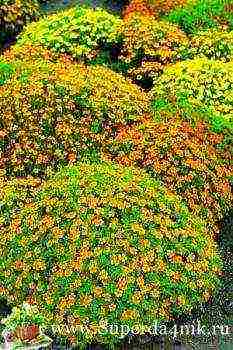 Thin-leaved marigolds are used in landscape design to create flower beds - rabatok. Each bush looks like yellow, orange, red-yellow and even white fireworks in a flower bed. These varieties are undersized marigolds, about 20-40 cm, strongly curly. The smell is pleasant and not as pungent as other types of tagetes.
Thin-leaved marigolds are used in landscape design to create flower beds - rabatok. Each bush looks like yellow, orange, red-yellow and even white fireworks in a flower bed. These varieties are undersized marigolds, about 20-40 cm, strongly curly. The smell is pleasant and not as pungent as other types of tagetes.
The best thin-leaved marigold varieties:
- Lemon gem (lemon-yellow inflorescences on dwarf bushes),
- Starfire (dwarf (about 15 cm) bushes with dark orange flowers),
- Mimimix,
- Karina orange,
- Golden Ring (40-50 cm),
- Dwarf.
Rejected marigolds (French) varieties
Low-growing marigold varieties belong mainly to this species. The maximum height of the bushes is 60 cm. Rejected terry marigolds abundantly cover the bushes, which, when tightly planted, form a low hedge. Therefore, they are often used for casing paths, curbs, curbs, chain-link fences and other fences. They are most often found in gardens and in personal plots. Rejected marigolds have a varied, often combined color. Medium-sized inflorescences - 3-3.5 cm in diameter. The most popular among gardeners today are marigolds, undersized, large-flowered. Much attention is paid to the breeding of such varieties. They have a rather pungent odor.
Note to the gardener: the spicy smell of marigolds is very disliked by bugs and Colorado beetles. When planting potatoes and tomatoes, which striped pests like to feast on, you can take this into account and build a kind of buffer zone from marigolds, free from Colorado beetles.
Of the rejected varieties, you should pay attention to:
- Gold Copchen (terry),
- Gold Ball (plain or semi-double),
- Bonanza (terry),
- Carmen (terry).
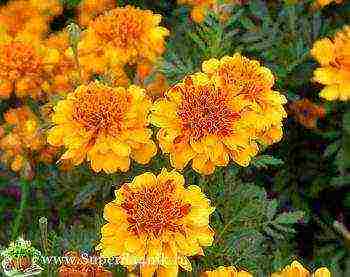
French marigold varieties
Erect marigolds (African)
High ornamental varieties of Tagetes, inflorescences are mostly monochromatic, large (up to 15 cm), grown for cut (cut varieties). The height of the bushes is from 30 to 120 cm. All flowers are double. White marigolds for flower gourmets are erect. They look very beautiful in a flower garden both independently and with other varieties. Using the best varieties of marigolds of different types, colors and heights, you can build a multi-tiered flower bed.
Marigolds erect varieties:
- Goldlicht (large bright orange flowers),
- Kilimanjaro (a rare species of tall, white, terry marigolds),
- Eskimo (white marigolds with a bush height of about 30-40 cm),
- Sonnenschein (lemon yellow inflorescence on a relatively low bush),
- Vanilla (white, large, about 12 cm in diameter, inflorescences).
Perennial marigolds. Planting and caring for marigolds
Tagetis is a sun- and heat-loving plant. In Mexico, America and Africa, where marigolds grow naturally, it is perennial. In our climatic conditions, marigolds can only be grown as annuals, because they are not able to overwinter in the soil. The perennial effect creates the fact that marigolds abundantly throw out their seeds, which do not lose their vitality over the winter and sprout on their own in the spring in the same place.
In open ground, marigolds are planted with seedlings or seeds. You will need to start sowing seedlings in February.This option is suitable for "industrial production" for the purpose of centralized landscaping of large cities, when small bushes of seedlings with the first flowers are planted in the ground. At home, marigolds are planted with seeds directly into open ground in May, and in early June they already begin to bloom. Marigolds are very unpretentious: they feel good both in the shade and in the sun, they are unpretentious to watering, they can be transplanted without harm even during the flowering period.
After the inflorescence dries, do not forget to collect the seeds so that the flowers will delight you next year. Marigolds are cross-pollinated. If you have planted varietal marigolds of different colors in one place, then be prepared for the fact that by planting the collected seeds next year, you can get a completely new and completely unexpected color of inflorescences. Therefore, in order to preserve the color of varietal marigolds, it is necessary to prevent them from pollination with flowers of a different color. To do this, bushes of different colors must be planted in a flower bed as far as possible from each other.
Rate the quality of the article. We want to be better for you:


